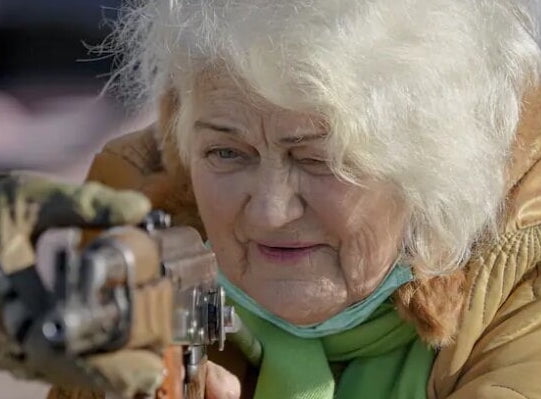
By now we’ve all see satellite pictures of the leaf-cutter file of green Russian trucks, tanks and Tygr armored cars crawling along Ukraine’s empty roads and highways toward Kyiv. We’ve also seen images of frantic Ukrainian women clutching toddlers and clawing their way toward Poland and safety.
But, long before this war started, millions of able-bodied Ukrainians had already left the country and its black, distinctly fertile “chernozem” soil. Ukraine’s population was about 41 million when Russia invaded last week—down from about 52 million in 1991.
The exodus drained Ukraine of many of the workers it needed to raise its standard of living closer to European Union levels. The loss of workers also drove up the “dependency ratio” of old people to working-age people, and wrecked an already threadbare state pension system. (My great-grandfather left western Ukraine, then Eastern Galicia, in the 1880s.)

A pensioner in Ukraine aims an assault rifle.
Ukraine’s traditional pay-as-you-go basic national pension operated on the “solidarity” principle. Young people supported their parents and grandparents. Of the ~11 million retirees in Ukraine (as of mid-2021), 65% received a pension below 3,000 hryvnia (€95, $105) per month. Only high-ranking former public officials (2.7% of the population) received a pension of over 10,000 hryvnia (€317, $351) a month. In one interview, a Ukrainian told a reporter that many men volunteered for dangerous industrial jobs in order to qualify for an earlier, larger pension.
After Ukraine declared independence from the Russian Federation in 1991, it tried to establish a three-legged pension system on the OECD (Organization of Economically Developed Countries) model. In addition to the Solidarity pension, a defined contribution plan with individual accounts funded by 7% of pay contributions, as well as private pensions, were proposed. They were either insufficient or incomplete. A period of high inflation in the 1990s didn’t help. Neither did the financial crisis of 2009.
But Ukraine’s fundamental pension problem is demographic. The population has been shrinking by an average of over 300,000 annually since 1993. As of 2007, the country’s rate of population decline was the fourth highest in the world. Environmental pollution (Ukraine is home to the 1986 Chernobyl reactor disaster), poor diets, smoking, alcoholism and deteriorating medical care also give Ukraine a high mortality rate.
And Ukraine is impoverished. Despite the photographs we see on TV of historic Lviv (a time capsule of 19th century architecture, and a World Heritage preservation site) and the modern subway in Kyiv, Ukraine is the poorest country in Europe. It’s not only poorer than the countries of western Europe. It’s also poorer than the Balkan states of Albania, Serbia, Kosovo and Montenegro.
“With a per capita gross national income (GNI) of $3,540, Ukraine is the poorest country in Europe as of 2020. Ukraine once had the second-largest economy in the USSR. However, when the USSR collapsed, Ukraine had difficulty transitioning into a market economy, which sent much of the population into poverty. Some of Ukraine’s continuing issues contributing to its poverty are government corruption, Russian aggression (specifically Russia’s illegal seizure of Crimea in 2014), and weak infrastructure,” one source said.
In the vacuum after the fall of Communism, Ukraine seems to have retained the worst vestiges of the socialist era—with its centralized controls and stifling of enterprise—and entertained the most piratical strain of capitalism. As in Russia after 1991, a handful of insiders (the “red directors” who became “oligarchs”) took personal control of the former state monopolies on agriculture, natural gas, and other resources. They vastly enriched themselves at the expense of the nation.
Ordinary Ukrainians have been living in a kind of hell. But most of the urban Ukrainians we see on TV or online don’t seem very different from us. We’ve all seen interviews with rumpled but clearly 21st-century Ukrainian men and women who look and sound like Westerners—wearing bluejeans and parkas, holding cellphones or lidded go-cups of cold coffee, and speaking accented but flawless English—and who say the words that we would say if we were in their shoes: “I can’t believe this.”
© 2020 RIJ Publishing LLC. All rights reserved.

